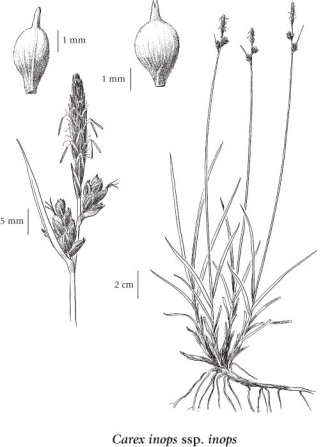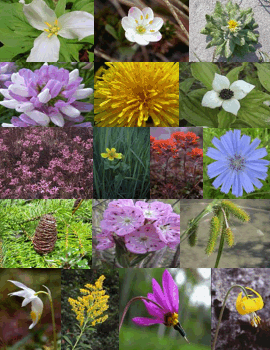Carex inops L.H. Bailey subsp. inops
long-stoloned sedge (long-stolon sedge)
Cyperaceae (Sedge family)
Introduction to Vascular Plants
long-stoloned sedge (long-stolon sedge)
Cyperaceae (Sedge family)
Introduction to Vascular Plants
Species Information click to expand contents
General:
Perennial, tufted herb from slender, creeping, branched rhizomes; stems (10) 20-50 cm tall, clustered, usually longer than the leaves, reddish-brown tinged at the bases.
Leaves:
Sheaths tight, breaking into threads at the bases; blades flat, channeled towards the base, 5 to 10 per stem, the margins somewhat turned in, borne on the lower 1/3 of the stem, 1-3 mm wide, the lower ones slightly reduced.
Flowers:
Spikes 2 to 4, the terminal one 1-2.5 cm long, the stalks 0.8-10 mm long, with many male flowers, the lower spikes 1 to 3, with female flowers, unstalked to short-stalked, erect; bracts subtending the lowest spike leaflike, sheathless or short-sheathing, shorter than the inflorescence, the others short, inconspicuous.
Fruits:
Perigynia broadly egg-shaped to nearly globe-shaped, 2.5-4.5 mm long, 2-2.3 mm wide, dull green to straw-coloured, convex, finely short-hairy, with 2 prominent marginal nerves, the bases short-stalked, the beaks 0.5-1.5 mm long, bidentate; female scales egg-shaped, rounded to tapered, slightly longer to somewhat shorter than the perigynia, straw-coloured to brownish, with lighter midribs, with translucent margins; stigmas 3; achenes 3-angled, with convex sides above, smooth, 1.8-2.5 mm long.
Notes:
Two subspecies occur in BC :
1. Lower female spike elongate, short-stalked, its bract often short-sheathing; stalks of the male spike 4-10 mm long.................... ssp. inops
1. Lower female spike short, unstalked, its bract sheathless; stalks of the male spike 0.8-5 mm long.................... ssp. heliophila (Mack.) Crins
Illustration click to expand contents

If more than one illustration is available for a species (e.g., separate illustrations were provided for two subspecies) then links to the separate images will be provided below. Note that individual subspecies or varietal illustrations are not always available.
Illustration Source: The Illustrated Flora of British Columbia
Ecology click to expand contents
Ecological Framework for Carex inops ssp. inops
The table below shows the species-specific information calculated from
original data (BEC database) provided by the BC Ministry of Forests and Range.
(Updated August, 2013)
The table below shows the species-specific information calculated from
original data (BEC database) provided by the BC Ministry of Forests and Range.
(Updated August, 2013)
| Site Information |
Value / Class |
||
|
Avg |
Min |
Max |
|
| Elevation
(metres) |
388 | 27 | 2010 |
| Slope
Gradient (%) |
26 | 0 | 84 |
|
Aspect (degrees) |
149 | 23 | 360 |
| Soil
Moisture Regime (SMR) [0 - very xeric; 4 - mesic; 8 - hydric] |
2 | 1 | 8 |
| Modal
Nutrient Regime
Class |
B | ||
| #
of field plots species was recorded in: |
44 | ||
| Modal
BEC Zone Class |
CDF | ||
|
All BEC Zones (# of stations/zone) species was recorded in |
BWBS(3), CDF(32), ESSF(2), IDF(3), SBS(1) | ||
|
Source:
Klinkenberg 2013
|
|||
Habitat and Range click to expand contents
Mesic to dry oak woodlands, meadows and rock outcrops in the lowland, montane and steppe zones; ssp. inops - infrequent in SW and SC BC; ssp. heliophila - infrequent in NE BC; ssp. inops - S to CA; ssp. heliophila - E to ON and S to IN, MO, OK, NM and UT.
Synonyms click to expand contents
Synonyms and Alternate Names:
Carex pensylvanica Lam.
Carex pensylvanica var. vespertina
